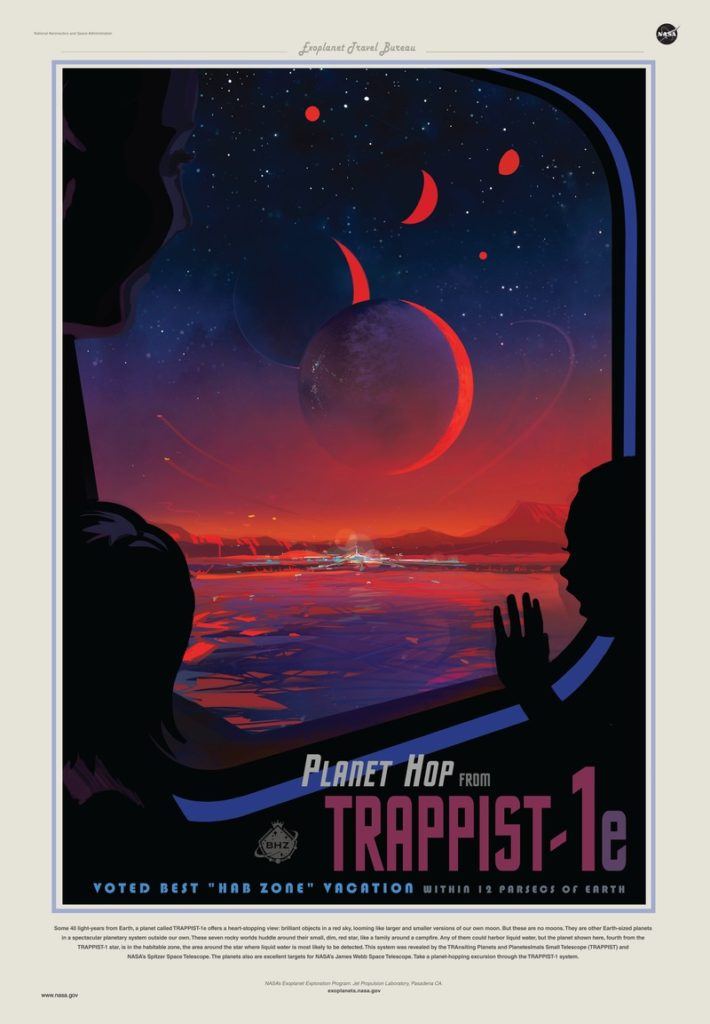Here’s what’s going to happen. It will get hot. Very hot. The oceans will expand and the ice caps will melt, and nearly half of the Netherlands and a quarter of Vietnam will be submerged. We’ll move: first to the Polar Regions and then, when crops start to fail, to other planets, where we can start again. There, we’ll drive hovercars to work each day. Or maybe there is no work, our human labor having been rendered unnecessary. Holographic cooking shows will show us how to spice up our Soylent dinners, which we’ll watch as we squabble with our AI lovers.
All of this is — for now, at least — science fiction. But for NASA, this kind of speculative fantasy can be used to excite the public imagination about their work. When, on February 22, NASA discovered a series of potentially habitable new planets around the dwarf star Trappist-1, about 40 light years from Earth, they set to work visualizing a future. The agency commissioned a series of artworks to celebrate the discovery, including imagined landscapes, a 360-degree interactive illustration, and a hypothetical travel poster inviting humans to what is thought to be the most habitable of the planets: Trappist-1e.
The nostalgia the NASA poster draws on is a recoding of capitalism’s animal spirits, not a wistful dream of escape. Space colonization becomes conditional on extraction
The poster shows a landscape vaguely reminiscent of the Australian outback: dry, seemingly deserted, with silhouetted mountains lining the horizon. The sky, a deep blue seeping into fuchsia, is crowded with the other planets of the Trappist-1 system. In the very center of the poster, floating on a glittering sheet of water, is a large glass building. This dome — seemingly the default shape of all imagined space architecture — radiates luminescent blue light, while spider-like spindles extend outward from its hub. In the foreground, looking through the window of a space shuttle, are three figures in deep shadow, one open-mouthed in awe. They are approaching the space colony of Trappist-1e, ready to begin their vacation on what the poster claims to be the “best ‘hab zone’ vacation within 12 parsecs of Earth.”

With its “ultracool” dwarf star off toward the Aquarius constellation, Trappist-1e evokes 1960s counterculture, which the poster nods to in its typeface and lightly textured block colors. But it also looks back to another aesthetic tradition of the 20th century: the illustrated travel poster. It is just one of an entire series NASA has commissioned to engage the general public — part of what the agency calls its Exoplanet Travel Bureau.
Once, before the age of airport pat-downs and forcible “re-accommodations,” overseas travel was a glamorous, expensive affair. Travel posters were meant to illustrate the exotic appeal of other countries, evoking national identities (or ad agencies’ ideas of them) with several flicks of a paintbrush. One poster dating from the 1950s, designed to promote travel to Egypt, shows two affluent white tourists on camelback, gazing onto the pyramids of Giza. It’s alluring, elegant, and exotic. But an image can conceal as much as it reveals. From this poster it would be near impossible to know that at almost the same moment Egyptians were fighting to end the British colonialist occupation.

NASA’s nostalgic space travel posters have a similar dimension. The palpable air of adventure is meant to be playful, evoking the same curiosity that has birthed countless science fiction books and movies. But in using the visual language of fantasy, the poster obfuscates fact: We are genuinely facing an enormous, multi-species threat here on Earth. Sea levels will absolutely rise, and we will face unprecedented famine, mass migration, and suffering. By the end of the century, it is estimated that we will lose about 50 percent of terrestrial flora and fauna to extinction. Capitalism has spent more than two centuries spewing out carbon dioxide, nitrogen, and other pollutants, causing profound planetary harm. And yet we inhabit a world where political leaders deny this reality. The NASA poster posits an alternative to trying to anticipate and forestall the chaos that global warming will unleash. In the face of earth’s decline, space colonization is both possible and inevitable.
That echoes the spirit of Elon Musk, whose company SpaceX shares similar ambitions. Within the next 50 to 100 years, he claims, we’ll have a self-sustaining and permanent human colony on the Red Planet. When he outlined SpaceX’s colonization plan last year, Musk made clear that “two fundamental paths” lie ahead of us: “One is that we stay on Earth forever and then there will be an inevitable extinction event. The alternative is to become a spacefaring civilization and a multiplanetary species.”
This is more than crackpot futurism. Musk is a key member of the Strategic and Policy Forum, Donald Trump’s business advisory assembly — a group that also includes the CEOs of JPMorgan, Pepsi, and IBM. Musk’s membership should ensure that SpaceX’s hyperbolic ambitions reach the president’s ears. Moreover, back in January, Trump made a (characteristically vague) statement about wanting to “unlock the mysteries of space.” Not coincidentally, he also proposed cutting funding for climate research on earth. For Trump, it is space and not his home planet that will offer “the energies, industries, and technologies of tomorrow.”
But Trump is not the only recent U.S. president who has been interested in space projects. In 2015, President Obama signed a bill that opened up the rights for miners to extract, use, and trade mineral resources found in space. The Spurring Private Aerospace Competitiveness and Entrepreneurship Act — otherwise known as the SPACE Act — extends capitalism’s already global tentacles to outer space. The amount of money at stake is almost hard to imagine: The value of near-Earth asteroids alone, anticipated to be the first target for space mining, is estimated at $100 trillion, roughly equivalent to the GDP of all of Earth.
From the vantage point of 2017, outer space appears to serve two apparently contradictory functions in the public imaginary. It offers a way out of the climate change brought on by rapacious global capitalism and its heedless reliance on extracted fossil fuels, yet it also provides private enterprise with irresistible new sites for further extraction. These minerals and resources will prop up capitalism as we know it, and its inevitable effects. Paradoxically, outer space is both an escape from, and subsistence for, capitalism.
Capitalism, as Rosa Luxemburg once wrote, requires something outside itself, a periphery not yet negotiated by capitalist relations: Like Kiefer Sutherland in The Lost Boys, it must devour, or die. Marx traced European capitalism to an initial act of “primitive accumulation” between the 15th and 18th centuries, when common lands were expropriated and privatized. This, as Marx put it, “clears the way for the capitalist system”: the means of production are taken from the many and given to a wealthy few.
In 2017, however, there’s nowhere “outside” left. There is no periphery from which to accumulate. Capitalism is global. If you’re reading this, it’s likely that every aspect of your life is steeped in it. If a cash injection is needed, where else can it be found but outer space?
Today, there are more than 1,000 private space initiatives in operation in the U.S. One of the largest is Planetary Resources, a commercial mining company that lobbied heavily for the SPACE Act. The company’s slogan echoes the spirit of adventure on display in the NASA poster, with an added dose of juvenile provocation: “We dare you to change the course of humanity with us.” It describes the extraterrestrial resource grab as the “next Gold Rush,” evoking all the Wild West fantasies that accompany that idea. It calls asteroids “low-hanging fruit,” as if their minerals should be understood as being simply there for the taking.
Trump says he wants to “unlock the mysteries of space.” Not coincidentally, he also proposed cutting funding for climate research on earth
The SPACE Act, much like the 1967 Outer Space Treaty before it, forbids anyone to “assert sovereignty, or sovereign or exclusive rights or jurisdiction over, or the ownership of, any celestial body.” This means that, although private companies are permitted to mine in space, they cannot claim the land itself. Space and its territories were considered to be an international commons even before space travel was a possibility. (Thus Moon Estates, which claims to sell prime lunar real estate for just $20 an acre, is selling snake oil.)
The SPACE Act creates a legal loophole of sorts, in which one can extract everything an asteroid’s got without claiming formal ownership of the territory itself. But is there really much of a difference between claiming ownership of land and claiming all its resources? Chris Lewicki, Planetary Resources’ CEO, doesn’t seem to think so. He sees his company’s work as a direct precursor to other more ambitious projects. “The first space colonies, tourist destinations, commercial laboratories all will be enabled by [our] business,” he says. For him and others like him, the future shown in NASA’s Trappist-1e poster, a planet terraformed for human consumption, depends ultimately on the profit-making initiative of private interests. The nostalgia for adventure it draws on is a recoding of capitalism’s animal spirits, not a wistful dream of escape to a world without capitalism. Space colonization becomes entirely conditional on extraction.
History would seem to bear this out: In the 18th century, when the East India Company was at the height of its powers, it accounted for half the world’s trade — buying, selling, and transporting commodities like cotton, tea, and opium. Its business model was one of extraction and exploitation, what Stanford economist Paul Baran describes as “plunder thinly veiled as trade.” In India, the company even held its own private army, fought in several wars and, as the Mughal Empire began to decline, seized territorial control. Indian territory remained with the company until 1858, when sovereign powers were handed over to the British Empire. Needless to say, the legacy of such widespread colonial theft can still be felt in the Global South to this day.

The illustrated posters of the 19th century were key in constructing and maintaining imperialist ideology. Tea, coffee, cocoa — all products from colonial regions — required the creation of new market desires in Europe. Posters played a huge part in this, stimulating fantasies in European consumers while simultaneously erasing colonial oppression and subjugation. In an 1892 advert for Lipton’s Teas, for example, a woman in traditional Sri Lankan dress sips from a teacup, her face fixed with a slight Mona Lisa smile. Through an exoticized visual language of desire, these posters served to create new wants that could substantiate an entire regime of economic imperialism. NASA’s Trappist-1e poster can be seen as having similar ambitions, offering an idealized depiction of space colonization that both obscures and rationalizes the capitalist imperatives that drive it.
Looked at in these terms, space colonization begins to look less visionary and more like maintenance of the status quo. Scrambling for resources to uphold a broken system, whether in the Global South or on Trappist-1e, is a centuries-old story. In The Case for Mars (1996), Robert Zubrin certainly makes no bones:
Mars is to the new age of exploration as North America was to the last. The Earth’s Moon, close to the metropolitan planet but impoverished in resources, compares to Greenland. Other destinations, such as the Main Belt asteroids, may be rich in potential future exports to Earth but lack the preconditions for the creation of a fully developed indigenous society; these compare to the West Indies.
For Zubrin, resource extraction from space is directly analogous to extraction from colonized nations. It’s all just frontier.
Faced with a blank canvas, we’re all, to some extent, toddlers with a fistful of crayons. Our imaginations run wild when we think about what we could achieve with other planets. We could leave this trash-can planet behind, with all its wars and climate change and corrupt politicians, and start over. Earth doesn’t have to be the main event but rather a rehearsal for utopia. It certainly sounds easier than trying to fix the mess down here.
In Ursula K. Le Guin’s novel The Dispossessed, this is almost exactly what happens. After attempting to forge a revolution on their own Earth-like planet, a group of separatists flee to the neighboring planet Anarres. Here they create a collectivist society on anarcho-socialist principles and, despite the planet’s harsh conditions and resource scarcity, society functions relatively smoothly. Could a more palatable version of space colonization take this form? Could it provide us with a less, for want of a better word, alienated existence?
It’s the same impulse that drives people to move to a new city after a difficult breakup or losing a job. But when we start losing entire countries to rising sea levels, or when crops fail year after year from the heat, who will get to be the ones to flee? There is simply no reason that the same power structures that dominate earth will dissipate in space. It is likely, rather, that any otherworldly getaway will be reserved for a more privileged class. For the rest of us, it means abandonment — or even servitude — in the intergalactic equivalent of today’s Global South. And, in the present moment, how can we possibly resist, organize, if we believe we can leave this planet all behind?
As it stands, we have no idea whether life already exists in the Trappist-1 system. Bacterial cells may be swapping DNA in a primordial soup, or there may be intelligent pulses of energy or electric radioactive serpents. Maybe there’s no life at all. But even the possibility raises questions about our right to disrupt communities we may not even be able to detect, let alone understand.
Nonetheless, NASA’s poster, with its ebullient faces peering out onto the Trappist-1 settlement, shows that before we’ve even begun to imagine what, or who, may already live on this planet, we imagine ourselves making a claim to it. To suggest that these planets — and the resources they contain — can be claimed simply because they exist, echoes a long and painful history. Space colonization, particularly one that expands the field of capitalism, cannot also be a decolonizing project.
